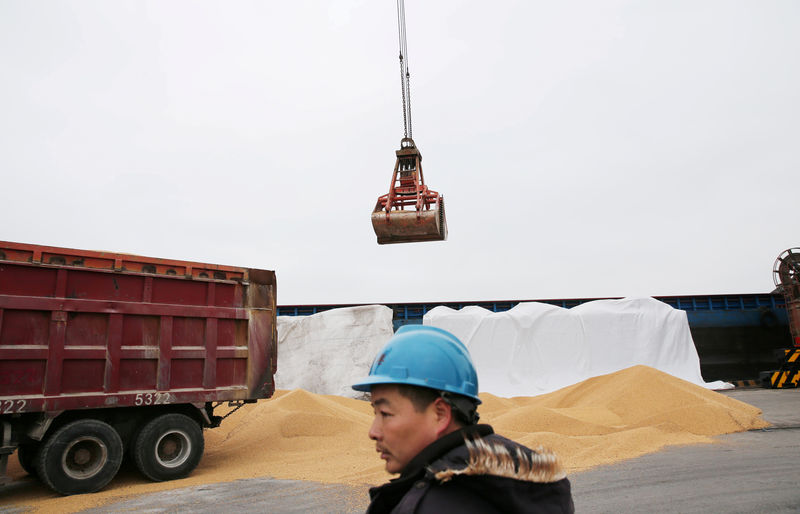By Yawen Chen and Kevin Yao
BEIJING (Reuters) - Chinese banks throttled back new lending in April after a record first quarter that sparked fears of more bad loans, but analysts say the central bank will likely have to step up support for the economy as trade tensions with the United States escalate.
Global investors are closely watching to see how much more support Beijing will inject to shore up growth. But those policy expectations are swinging wildly as a sudden blowup in diplomatic ties threatens China's nascent recovery.
U.S. President Donald Trump stunned financial markets this week by announcing he will hike tariffs on Chinese goods on Friday unless Beijing agrees to a trade deal, sharply escalating their dispute after months of negotiations. Beijing has vowed to retaliate.
The resurgence in external risks comes as China's economy was beginning to show tentative signs of stabilizing after a raft of growth-boosting measures.
More modest bank lending last month suggested the central bank was fine-tuning policy in light of recent encouraging data and concerns about a rapid rise in debt, economists at Nomura said in a note.
But they added: "We expect a rebound of money and credit in May.
"The sudden escalation of U.S.-China trade tensions and the recent sharp drop of stock prices could convince Beijing to take further easing measures to bolster confidence and stabilize growth."
Chinese banks extended 1.02 trillion yuan ($150.16 billion) in net new yuan loans in April, the central bank said on Thursday, well below analysts' expectations of 1.2 trillion yuan in a Reuters poll and March's surprisingly strong 1.69 trillion yuan.
Growth of outstanding total social financing (TSF), a broad measure of credit and liquidity in the economy, slowed to 10.4 percent from a year earlier from 10.7 percent in March. TSF growth is a rough gauge of credit conditions.
"The slowdown in credit growth underlines the need for further monetary policy easing in order to keep credit expanding fast enough to provide a floor to economic growth," Julian Evans-Pritchard at Capital Economics said in a note.
The credit data was released unexpectedly early, hours ahead of the resumption of last-ditch U.S.-China trade talks and a day ahead of the threatened U.S. tariff hike. The data is typically released between the 10th and 15th of every month.
While April lending levels have tended to moderate from March in past years, investors had been looking to details of the data for clues on how much more policy easing to expect.
The People's Bank of China (PBOC) said on Monday it will cut reserve requirement ratios (RRR) for some small and medium-sized banks, in the latest in a series of moves specially tailored to help small firms struggling amid the economic slowdown.
PRICE PRESSURES
Other data on Thursday showed price pressures in China were rising, with April consumer inflation quickening to a six-month high of 2.5 percent.
But analysts noted much of the pick-up was due to higher pork prices, and the trend did not stand in the way of policymakers if further easing is needed to offset mounting trade pressures. The CPI reading remained below the government's annual target of around 3 percent.
Indeed, factory-gate inflation also quickened in April, to a four-month high of 0.9 percent, suggesting underlying demand may be starting to improve.
"Renewed uncertainty in China-U.S trade relations will likely add to policymakers' determination to stay the course on policy easing," said Julia Wang, China economist at HSBC.
"There is still a lot of slack in the economy. This means the PBoC has room to look past temporary shocks in pork or oil prices and focus instead on core inflation," which has been relatively steady.
LESS ROOM FOR POLICY EASING?
Some analysts believe the PBOC has less room to ease monetary policy this year after it cut RRRs and interest rates aggressively in past economic downturns. Beijing has been leaning more on fiscal stimulus this time, counting on higher infrastructure spending and tax cuts to stoke growth.
The OECD has estimated that China's fiscal stimulus was equivalent to 4.25 percent of gross domestic product (GDP) in 2019, up from 2.94 percent last year.
ING estimates China has announced support measures worth about 8 trillion yuan in 2018 and 2019, twice as much as its last major stimulus program during the global financial crisis, though a smaller proportion of GDP than a decade ago.
Top officials have repeatedly vowed not to open the credit floodgates in an economy already saddled with piles of debt - a legacy of massive stimulus during the financial crisis and subsequent downturns.
Analysts believe the central bank will continue to cut reserve requirements for lenders, on top of five reductions since early 2018, though they expect it will refrain from more aggressive measures such as cutting benchmark interest rates which could add to debt levels and pressure the yuan currency.
However, some China watchers believe a benchmark rate cut cannot be ruled out if conditions sharply deteriorate.
